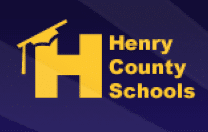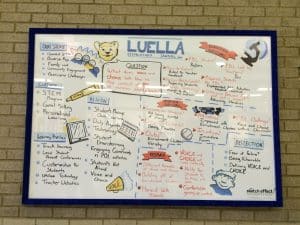Henry County Schools: Four Big Takeaways
CompetencyWorks Blog
 We are going to try something different here. Our case studies are getting longer as we learn more. So instead of our releasing one blog post in a series at a time, we are going to release all of them at the same time with interlocking links.
We are going to try something different here. Our case studies are getting longer as we learn more. So instead of our releasing one blog post in a series at a time, we are going to release all of them at the same time with interlocking links.
Post #1: Four Big Takeaways (includes background)
Post #2: Ensuring Success for Each Student
Post #3: Scaling Strategies for Mid-Size Districts
Post #4: What All of This Means for Schools
Post #5: Impact Academy
Let us know if this works better for you. You’ll need to dedicate ten to fifteen minutes to read it. Our hope is that it will make it easier for you to draw out the insights that are important to you while still building more background in competency education.
Overview
Just outside of Atlanta, Georgia, Henry County Schools (HCS) operates fifty schools serving 42,000 students. It covers a mix of four cities and towns, some rural and others more suburban. The district is the largest employer in the area (over 75 percent of workers leave Henry County for work daily), with many people commuting to Atlanta or other suburbs to work.
Historically, HCS has performed relatively well, but enormous changes over the past fifteen years – including enrollment nearly doubling, the percentage of students who are FRL tripling to 60 percent of the population, and increases in racial diversity (HCS is now 33 percent white, 51 percent African-American, and 9 percent Hispanic) – created an opportunity for change. In 2013, the district created a strategic plan to transform their schools to personalized learning by 2020. One of the five pillars of this plan is competency-based learning. Although it’s always hard to determine causal relationships, Henry County has already had a 6.4 percent increase in their four-year graduate rate since they began this work. They are certainly going in the right direction.
Under the leadership of Superintendent Rodney Bowler, the school board identified multiple reasons for turning to personalized learning, including:
- Better prepare an increasingly diverse student body for college, career, and life success
- Move from “good enough” to “exceptional”
- Traditional model is no longer sufficient
- Nature of knowledge has changed
- Information is ubiquitously available
- Focus on metrics beyond standardized tests
- People learn in different ways (Pace, Place, Path, People)
Superintendent Bowler says, “Henry County Schools is excited about the work being done across our schools to transform them to personalized learning schools. When you look at the core of personalized learning, it fits nicely with our mission of ensuring success for each student. Focusing on each student and their individual needs and learning styles is truly the best approach to equipping them for college, a career, and life in general. It was a no-brainer for us to make this move, and while the work has been tough, our teacher, students, and our communities that have started the transformation have seen great growth for everyone involved. We know that when all is said and done, our district will be a strong example for others looking to make this strategic change for the betterment of our learners and our future.”
It’s worth taking a minute to look at the Georgia state policies that shape Henry County’s strategy. GA does offer a seat-time waiver that allows courses to be mastery-based. Henry County has a strategic district waiver that allows them great freedom, excluding a handful of exceptions. GA state policy has also made a firm commitment to a number of secondary school policies designed to improve graduation rates and college-going rates. In addition to early college and career academies, Georgia offers Move on When Ready, which establishes a dual enrollment program that requires students to meet the admissions policy of the partnering institution of higher education. HCS is also partnering with Southern Crescent Technical, Georgia Tech, University of Georgia, and others. The district provides the transportation costs, and the state pays for the courses. Finally, the Hope Scholarship program will pay for college for students up to a master’s degree when they have a 3.2 GPA in high school and college. In addition to assessing grade level standards, Georgia’s state accountability system also uses growth measures.
In 2015, the statewide Education Reform Commission released a report that included recommendations for expanding the understanding of “move on when ready” to include making the transition to a competency-based system. (Turn to page 26 of the report.) Anthony Townsend, Principal at Locust Grove Middle School in HCS, was appointed to the Commission.
My Big Takeaways
What really stands out at Henry County Schools is the comprehensiveness of their transformation. (Check out their video on personalized learning.) They aren’t just using blended, or just being competency-based, or just deepening the learning, or just adding project-based learning. They are making a full transition to a personalized approach that draws on five tenets. (See the post Ensuring Success for Each Student.)

#1 Laying the Groundwork with School Autonomy: In the report on Implementation, the first step was to engage the broader community in creating a shared vision. That’s much easier for smaller districts to do than larger ones. For larger districts, I think that embracing and operationalizing school autonomy is the important first step. This can be a huge change for districts, so if you are thinking about becoming competency-based, you might want to start empowering schools now. For states, you might want to include school autonomy as an indication of “readiness” to larger districts to start down the path toward competency education.
Recommendation: We need to bring in the experts on helping districts create school autonomy and manage a portfolio of schools to ensure we are drawing on previous experiences.
#2 Strong Vision for Personalization with Competency-Based Infrastructure as the Glue: At CompetencyWorks we have always said that districts should start with personalization as the vision, with competency education to be considered the skeleton upon which it rests. In discussions with Henry County, I learned two things. First, that a strong operational strategy for personalization adds a lot of depth toward the vision. Second, for larger districts using a strategy that allows schools to advance toward competency education “at their own pace” and with different entry points, the competency-based infrastructure becomes the glue to ensure quality control and equity.
Given that schools are moving forward differently (loose), it is vital that districts engage schools in the creation of the competency-based instruction and assessment framework (tight). However, it also needs to be done early on so that the leading schools are not held back. Thus, districts are going to need a very strong understanding of the design features of the competency-based structure or work with a technical assistance provider. They are also going to need to engage schools with diverse approaches early in the conversation to ensure the model can be applied to schools with different pedagogical approaches.
Recommendation: It would really help our efforts to expand competency-based education if we could have a focused process to look at different models and their implications so that districts can make informed choices and district staff could build expertise more quickly.
#3 Scaling a Comprehensive Transformation Process: Henry County Schools has developed a very comprehensive implementation plan for a very comprehensive transformation. I love the idea of a “pay it forward” scaling strategy. You learn something to the point that you have confidence that you are doing it well, then it’s time to introduce the idea to someone else. Another part of their process is to constantly reflect and capture lessons learned.
#4 Operationalizing Great Schools Partnership Proficiency Learning Structure: Great Schools Partnership has played a catalytic role in New England in supporting state policymakers and districts in the efforts to advance competency-based education. If you haven’t checked out their resources on proficiency-based learning, you definitely should.
Although Great Schools Partnership has been providing support to districts, I hadn’t visited a district before that was using their model for organizing competencies, including performance indicators and learning objectives and their system of assessments. HCS has taken this framework and applied it to everything from cross-cutting competencies to physical education. Although we still need to see how it will work in the classroom and what adjustments might need to be made, I’m thrilled to see another model that can help districts accelerate their process.
FYI – You can find resources on Henry County below:
- District context, the case for the shift to PL, high-level vision, and plan (here)
- District PL website (here)
- Competency documents (here)
—
Part 2 – Henry County Schools: Ensuring Success for Each Student
Part 3 – Henry County Schools: Scaling Strategies for Mid-Size Districts
Part 4 – Henry County Schools: What All of This Means for Schools
Part 5 – Henry County Schools: Impact Academy